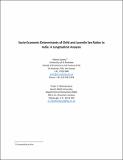Files in this item
Socio-economic determinants of child and juvenile sex ratios in India : A longitudinal analysis
Item metadata
| dc.contributor.author | Saxena, Vibhor | |
| dc.contributor.author | Bhattacharya, P.C. | |
| dc.date.accessioned | 2022-02-22T11:30:02Z | |
| dc.date.available | 2022-02-22T11:30:02Z | |
| dc.date.issued | 2015 | |
| dc.identifier | 236416574 | |
| dc.identifier | 05659991-3021-43cc-bb84-61e88f9590ab | |
| dc.identifier.citation | Saxena , V & Bhattacharya , P C 2015 ' Socio-economic determinants of child and juvenile sex ratios in India : A longitudinal analysis ' . | en |
| dc.identifier.other | ORCID: /0000-0001-9411-5527/work/108918089 | |
| dc.identifier.uri | https://hdl.handle.net/10023/24921 | |
| dc.description.abstract | The paper examines the determinants of the child and juvenile sex ratios in India in a multivariate framework, using district level data from the 1981, 1991, and 2001 Indian population censuses. The results strongly suggest that there are deep rooted cultural factors at play in the determination of the sex ratios at birth and at early ages, cultural factors that are not much responsive to the enhancement of women's agency or to economic development. However, the results also show that the behaviour of the juvenile sex ratio does respond to the enhancement of women's agency and to economic development. Policy implications of these findings are considered. | |
| dc.format.extent | 24 | |
| dc.format.extent | 624309 | |
| dc.language.iso | eng | |
| dc.subject | Child and juvenile sex ratios | en |
| dc.subject | Socio-economic determinants | en |
| dc.subject | Longitudinal analysis | en |
| dc.subject | HB Economic Theory | en |
| dc.subject | HT Communities. Classes. Races | en |
| dc.subject | SDG 8 - Decent Work and Economic Growth | en |
| dc.subject.lcc | HB | en |
| dc.subject.lcc | HT | en |
| dc.title | Socio-economic determinants of child and juvenile sex ratios in India : A longitudinal analysis | en |
| dc.type | Working or discussion paper | en |
| dc.contributor.institution | University of St Andrews. School of Economics and Finance | en |
This item appears in the following Collection(s)
Items in the St Andrews Research Repository are protected by copyright, with all rights reserved, unless otherwise indicated.

